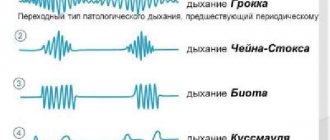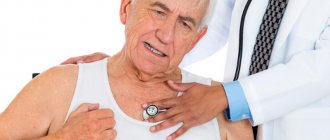If you have a feeling that breathing is difficult, and a lump has formed in your throat, then the situation may not be so harmless. It may seem that these sensations of lack of air are accompanied by pain in the chest and heart. In such cases, anxiety and sudden fear appear.
But, most often, such symptoms are not related to lung or heart diseases. This is a manifestation of the so-called hyperventilation syndrome, which appears against the background of psychogenic breathing disorder and is a common cause of apnea.
Briefly about the normal mechanism of breathing regulation
It has been scientifically proven that breathing is the only aspect of life support that a person can control. For example, we have the power to hold our breath or speed it up. The mechanism of conscious control manifests itself, in particular, when inflating a balloon, and the unconscious control mechanism - during sleep, for example, or when attention is switched to something else.
What is tachypnea?
Tachypnea is defined as an increased respiratory rate, or more simply, rapid breathing. Normal breathing rate can vary depending on age and activity, but is usually between 12 and 20 breaths per minute for a resting adult.
Unlike the term hyperpnea, which refers to rapid, deep breathing, tachypnea refers to rapid, shallow breathing.
Let's consider the physiological causes of tachypnea, as well as the diseases in which it can occur.
The essence of psychogenic breathing disorder
HVS, that is, hyperventilation syndrome or increased breathing, manifests itself in a state when the above-described scheme is disrupted. This happens under the influence of a psychic resonance. Medicine has long associated hot water supply with a high degree of stress.
Today this disease is quite common. It often affects those who snore in their sleep. Overall, it affected more than 12% of the world's population.
Tachypnea vs dyspnea
As noted, tachypnea is a term used to describe rapid, shallow (shallow) breathing, but this does not say anything about what a person is feeling. With tachypnea, a person may experience severe shortness of breath or, conversely, a person may not notice any difficulty breathing at all.
Shortness of breath (dyspnea) is a term that also describes rapid breathing, but refers to the feeling of not having enough air.
Dyspnea can occur with a normal respiratory rate, a high respiratory rate, or a low respiratory rate. It can also occur with both shallow and deep breathing.
Physiological reasons
Physiological causes of a condition refer to the body's normal response to eliminating another condition. In this case, a condition such as tachypnea is not an abnormal response of the body, but a normal response to another type of abnormal condition or imbalance in the body.
Tachypnea can be caused by three main physiological processes:
- Imbalance between respiratory gases in the body . Low levels of oxygen in the blood (hypoxemia) or elevated levels of carbon dioxide in the blood (hypercapnia) can cause tachypnea.
- Acid-base balance in the body . Tachypnea can be caused by excess acid in the body or a decrease in the alkaline environment in the body (acid-base imbalance). When the body senses that the blood is too acidic (i.e. metabolic acidosis), it releases carbon dioxide from the lungs in an attempt to rid the body of acid.
- Fever (heat) . High fever for any reason can cause tachypnea. During a fever, rapid, shallow breathing is a compensatory phenomenon, which means that the breathing rate increases to eliminate heat from the body.
In these examples, tachypnea is not an abnormal occurrence, but rather the body's way of compensating for another abnormality in the body to maintain balance (i.e., homeostasis).
Diseases that can lead to tachypnea
Rapid, shallow breathing can cause a wide range of illnesses. Depending on the categories, these may include:
- Lung diseases: Lung diseases that result in low oxygen levels or high carbon dioxide levels in the body may include chronic obstructive pulmonary disease (COPD), pulmonary sarcoidosis, asthma, pneumonia, pulmonary fibrosis, pneumothorax (collapsed lung), or pulmonary embolism. Rapid breathing is the body's way of trying to increase oxygen levels or decrease carbon dioxide levels in the blood.
In hospitalized people, tachypnea may be a sign of developing pneumonia and often occurs before other obvious signs of pneumonia appear.
- Heart disease: Conditions such as heart failure, anemia or hypothyroidism can lead to cardiovascular disease, which in turn causes tachypnea.
- Hyperventilation: This can occur due to pain, anxiety or other conditions.
- Metabolic acidosis: Occurs when the level of acid in the blood rises and the breathing rate increases to expel carbon dioxide. Some causes of this include diabetic ketoacidosis, lactic acidosis, and hepatic encephalopathy.
- Diseases Related to the Central Nervous System: Tachypnea can be directly caused by brain abnormalities such as brain tumors.
- Medicines: Medicines or substances such as aspirin, stimulants, and marijuana can cause rapid, shallow breathing.
More about the causes of tachypnea
Such symptoms are characteristic of various diseases. True, there are also natural factors that directly affect the increase in respiratory rate. We are talking about physical activity, emotional states and psychological stress. By the way, stress has recently become one of the most common causes. They can cause rapid breathing in healthy people.
But, as a rule, tachypnea develops as a consequence of impaired gas exchange: decrease in carbon dioxide - hyperventilation - rapid breathing. Naturally, the amplitude of breathing also decreases, which means the body is exposed to hypoxia. In this condition, the arteries contract and blood volume decreases. The result of all this is oxygen deficiency.
Also, tachypnea is often observed in a number of diseases with other characteristic symptoms.
- Heart attack and cardiac pathologies
- Anemia and complicated pneumonia
- Bronchial asthma and shock
- Rib pathology and endocrine disorders
- Hysteria and central nervous system lesions
- Thromboembolism and sternum trauma
- Infectious diseases and some medications
Symptoms of tachypnea
Tachypnosis may be accompanied by a feeling of difficulty breathing and an inability to breathe in enough air (dyspnea), a blue tint to the fingers and lips (cyanosis), and breathing that involves retracting the chest muscles.
Tachypnosis can also occur without any obvious symptoms, especially if it is associated with conditions such as metabolic disorders or diseases of the central nervous system.
Diagnostics
The diagnosis of tachypnea will vary depending on the person's age, other medical problems, medications, and other symptoms, but may include:
- Oximetry : This procedure measures oxygen concentrations in the blood. The test is used in the evaluation of various diseases affecting the function of the heart and lungs.
- Arterial blood gas analysis : Blood gases can give a more accurate estimate of oxygen levels as well as carbon dioxide levels in the blood. They will also tell your doctor your blood pH, which can be helpful in assessing metabolic disorders.
If your blood pH is low (acidosis), tests may be done to look for causes such as diabetic ketoacidosis, lactic acidosis, and liver problems.
- Chest X-ray : A chest X-ray can quickly identify some causes of tachypnea, such as a collapsed lung.
- Computed tomography (CT) scan of the chest: A CT scan of the chest is done to look for lung disease or tumors.
- Pulmonary function tests . Pulmonary function tests are very useful in looking for conditions such as COPD and asthma.
- Glucose test: Blood sugar levels are often checked to rule out (or confirm) diabetic ketoacidosis.
- Electrolyte analysis: Analysis of sodium and potassium levels are useful in evaluating some causes of tachypnea.
- Hemoglobin test: A complete blood and hemoglobin test may be done to rule out (or confirm) signs of anemia as well as infections.
- Electrocardiography (ECG): An ECG can look for signs of a heart attack or abnormal heart rhythm (cardiac arrhythmia).
- VQ scan (or ventilation pulmonary perfusion scan): A VQ scan is often performed if there is a possibility of a pulmonary embolism.
- Magnetic resonance imaging (MRI) of the brain: If other diagnostic tests fail to find a clear cause for tachypnea, an MRI of the brain may be done to rule out brain abnormalities (such as tumors) as the cause.
- Chemical toxicology studies : There are many prescription and over-the-counter drugs and illegal substances that can cause tachypnea. Chemical toxicological studies are often performed in emergency situations if the cause of tachypnea is unknown.
Signs and symptoms of the disease
The main symptoms are often caused by mental stress. Let's look at this more specifically:
- Autonomic symptoms are manifested by respiratory disorders in the form of rapid inhalation and exhalation and lack of air, cardiovascular disorders in the form of pain, severe compression and rhythm disturbances, gastrointestinal tract and urination disorders.
- Changes affecting the patient's consciousness - fainting, loss of reality.
- Motor and muscle disorders - tremors in the limbs, cramps, cold or heat, numbness or burning sensations, as well as pain.
- Disorders of mental etiology - anxiety, fear, aggressiveness, general excited state.
Diagnosis must be carried out by specialist doctors: therapists, endocrinologists, neurologists. The patient's complaints are listened to, a breathing test is performed: the patient takes quick and deep breaths for several minutes in a row.
Electromyography may be prescribed to identify hidden muscle spasms. The examination scheme involves a blood test, ultrasound of the thyroid gland and peritoneum, and x-ray of the lungs. In serious cases, a comprehensive examination is prescribed.
Tachypnea and lung cancer
Lung cancer can cause tachypnea in a variety of ways. Damage to the lungs can disrupt the normal exchange of oxygen and carbon dioxide. Scarring on the chest, such as from lung cancer surgery, can reduce the ability to breathe and take in oxygen.
Anemia caused by chemotherapy for lung cancer can lead to further worsening of tachypnea as there are fewer red blood cells in the blood to carry oxygen and therefore breathing becomes faster in an attempt to correct the problem.
Treatment of tachypnea
If attacks become frequent and are not caused by natural causes, the patient experiences weakness, panic attacks, pain, you need to consult a specialist. Most likely, in such a situation, tachypnea is associated with a specific disease, and its treatment is the therapy of the underlying disease. As part of the basic treatment regimen, rapid breathing is gradually eliminated.
To provide short-term relief, it is recommended to use a paper bag with a small hole. Place it on your mouth, holding the edges with your hand, and breathe for about five minutes. This optimizes gas exchange in the cells and the natural respiratory rhythm will be restored. It is also useful to do relaxing exercises.
Prevention
Prevention of an acute obstructive process in the bronchi is identical to the prevention of influenza and ARVI - these are annual, seasonal flu vaccinations. During the onset of cold weather in the off-season, it is necessary to avoid hypothermia and contact with already sick patients.
To prevent exacerbations of chronic obstructive bronchial disease, first of all, eliminate the external factors that cause it - tobacco smoking, dust in enterprises, work in a mine. Flu vaccination is carried out annually. For patients with chronic obstructive bronchitis, vaccination against pneumonia is carried out. It is carried out once every 5 years.
Treatment at special respiratory resorts is considered an important element of prevention. They exist in our country - Crimea. In Germany (Bad Reichenhall), southern coast of France, coast of Italy. The main task of a patient at a resort is active physical exercise in the fresh air.






